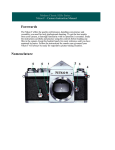Download Asahi Pentax ES Operating Manual
Transcript
Asahi Pentax ES Operating Manual Excerpts Reproduced for Historical and Reference Purposes by Paul M. Provencher http://whitemetal.com Not For Resale. 1 Asahi Pentax ES Operating Manual Excerpts Table of Contents NOMENCLATURE ........................................................................................................................................................2 SPECIFICATIONS .......................................................................................................................................................4 HOW IT WORKS..........................................................................................................................................................6 FILM LOADING AND WINDING..........................................................................................................................8 SETTING ASA FILM SPEED.......................................................................................................................................9 FILM TYPE REMINDER DIAL................................................................................................................................9 EXPOSURE FACTOR CONTROL DIAL............................................................................................................10 DIAPHRAGM SETTING...........................................................................................................................................11 TTL METERING AND AUTOMATIC SHUTTER............................................................................................12 OPEN-APERTURE OR STOP-DOWN READING.............................................................13 MECHANICAL SHUTTER.......................................................................................................................................14 FILM UNLOADING....................................................................................................................................................15 BATTERY CHECK AND REPLACEMENT .........................................................................................................16 FLASH SYNCHRONIZATION...............................................................................................................................17 DEPTH-OF-FIELD GUIDE.....................................................................................................................................18 INFRA-RED PHOTOGRAPHY ...............................................................................................................................19 MULTIPLE EXPOSURE............................................................................................................................................20 IMPORTANT NOTES................................................................................................................................................21 Reproduced for Historical and Reference Purposes by Paul M. Provencher http://whitemetal.com Not For Resale. 1 Asahi Pentax ES Operating Manual Excerpts NOMENCLATURE Reproduced for Historical and Reference Purposes by Paul M. Provencher http://whitemetal.com Not For Resale. 2 Asahi Pentax ES Operating Manual Excerpts Reproduced for Historical and Reference Purposes by Paul M. Provencher http://whitemetal.com Not For Resale. 3 Asahi Pentax ES Operating Manual Excerpts SPECIFICATIONS Type 35mm TTL-metering single-lens reflex camera with focal plane electronic shutter for automatic exposure control. Film and Picture Size 35mm film (20 ir 36 exposures). 24mm x 36mm. Standard Lenses Super-Multi-Coated Takumar 50mm f/1.4 and 55mm f/1.8 with fully automatic diaphragm. 7 elements in 6 groups. Distance scale: 0.45m (1.5 feet) to infinity. Filter size: 49mm. With depth-offield scale. Shutters TTL-metering electronic shutter for automatic exposure control + mechanical shutter for manual speed selection. Horizontal run focal plane shutter. Electronic shutter speeds: Unlimited variation between 8 and 1/1000 sec. Mechanical shutter: B, 1/60 (X), 1/125, 1/250, 1/500, 1/1000 sec. Viewfinder Eye-level pentaprism finder with Fresnel lens + microprism. 0.89x magnification with 50mm lens. -1.0 dioptry. Shutter speed calibration, TTL meter needle and battery "check" mark in the viewfinder screen. Focusing Turn the distance scale ring until the subject image in the viewfinder comes into sharp focus. Minimum focusing distance: 0.45m (1.5 feet). Reflex Mirror Instant return type. Film Advance Ratchet type rapid wind lever. and 160° advance angle. Reproduced for Historical and Reference Purposes by Paul M. Provencher http://whitemetal.com Not For Resale. 4 10° pre-advance Asahi Pentax ES Operating Manual Excerpts Film Rewind Rapid rewind crank. Film rewind button on base of camera body releases film from take-up spool for rewind. Film Exposure Counter Automatic re-set type. Cocked Indicator A red disk appears in a small window alongside the shutter release button when the shutter is cocked, and blacks out when it is released. Lens Mount 42mm thread (Pentax-mount). Flash Synchronization FP + X contacts for conventional flash cord connection. X contact on hot shoe for convenient cordless flash connection. Exposure Meter CdS-activated TTL meter for open-diaphragm and stop-down reading. Light measurement range: EV1 - 18 with ASA 100 film. ASA speed scale: 20 1600. Exposure Factor Control Dial 1x for normal exposure. 2x, 4x, 1/2x for intentional over- or under-exposure. Battery 6V silver battery (Eveready #544). Film Type Indicator * (black & white), * (color daylight), * (color tungsten) and EMP. (empty). Dimension Width 143mm (5.6") x height 98mm (3.86") x thickness 91mm (3.6"). Weight 940 gr. (2 lb. 1 oz.) Reproduced for Historical and Reference Purposes by Paul M. Provencher http://whitemetal.com Not For Resale. 5 Asahi Pentax ES Operating Manual Excerpts HOW IT WORKS A silver battery is packed separately. Be sure to insert it into the battery housing before operating the camera. For insertion, refer to page 19. 1. Load your film and set ASA film speed. 2. Keep this at "1x" for normal exposure. 4. Set shutter speed dial at "AUTOMATIC". Reproduced for Historical and Reference Purposes by Paul M. Provencher http://whitemetal.com Not For Resale. 6 3. Pre-select f/stop 5. Keep this lever down for openaperture exposure reading. (Lens aperture stays fully open, and stops down to pre-selected f/stop as you depress shutter release.) Move it up for depthof-field preview or for stop-down exposure reading. (Lens aperture actually stops down to pre-selected f/stop.) Asahi Pentax ES Operating Manual Excerpts 6. TTL Meter Reading. Softly depress the shutter button. Electric circuit is now switched on. Meter needle starts moving and indicates correct shutter speed. 7. Electronic memory device stores exposure reading information, whether through openaperture or stopped-down aperture. 8. Depress shutter button completely. 9. Memory device automatically releases electronic shutter. CORRECT EXPOSURE Reproduced for Historical and Reference Purposes by Paul M. Provencher http://whitemetal.com Not For Resale. 7 Asahi Pentax ES Operating Manual Excerpts FILM LOADING AND WINDING Avoid direct light when loading your film 1. Open the back by pulling out the rewind knob until the back cover snaps open. 2. Place the film cassette properly into the cassette chamber, and push down the rewind knob. Insert the film leader into the slot of the take-up spool. 3. Advance the film by alternately turning the rapid wind lever and depressing the shutter button until both sprockets engage the film perforations properly. Close the back by pressing it firmly. 4. Cock the rapid wind lever, and watch to see that the film rewind knob automatically turns counter-clockwise, indicating that the film is properly loaded and is moving from cassette to take-up spool. Trip the shutter. 5. The first portion of the film cannot be used for picture taking as they have already been exposed to light. Generally, two or three blank exposures should be made before taking your first picture. Therefore, advance the film until the exposure counter turns to "1", indicating that the first picture is ready to be taken. Reproduced for Historical and Reference Purposes by Paul M. Provencher http://whitemetal.com Not For Resale. 8 Asahi Pentax ES Operating Manual Excerpts SETTING ASA FILM SPEED The ASA film speed is given in the data sheet packed with each roll of film. The higher the ASA number, the more sensitive the film. Lift the outer ring of the exposure factor control dial, and turn it until the same number as the ASA number of the loaded film appears in the ASA speed indicator window. FILM TYPE REMINDER DIAL Use this dial as a reminder of the type of film loaded. To set the dial, pull out the rewind knob softly, and move the selector to the * for daylight type color film, * for tungsten type color film, * for black-and-white and EMP. when film is not loaded. Reproduced for Historical and Reference Purposes by Paul M. Provencher http://whitemetal.com Not For Resale. 9 Asahi Pentax ES Operating Manual Excerpts EXPOSURE FACTOR CONTROL DIAL The scale (4x 2x 1x 1/2x ) indicates exposure factor Turn the outer ring of the film type dial, and set 1x against the orange arrow for normal exposures. Use this control only when necessary to give intentional over- or under-exposures within the range of these factors while working on "AUTOMATIC". For example, set the dial at 2x or 4x when shooting against the light, and at 1/2x against dark backgrounds. In addition, the dial can be set between the indicated positions to achieve more specific exposure control. Reproduced for Historical and Reference Purposes by Paul M. Provencher http://whitemetal.com Not For Resale. 10 Asahi Pentax ES Operating Manual Excerpts DIAPHRAGM SETTING Set the shutter speed dial at "AUTOMATIC". Rotate the diaphragm ring to pre-select the desired aperture such as follows: Fine weather……………..f/8 - f/11 Cloudy weather………….f/4 - f/5.6 Indoor……………………f/2 - f/2.8 This is a rough guide to acquaint you with the automatic shutter operation. As you get used to it, you will have your own yardstick for aperture pre-selection depending on your subject and lighting conditions. The shutter speed of the ES is automatically determined at any speed within the range of 8 to 1/1000 sec. according to the brightness of your subjects. Reproduced for Historical and Reference Purposes by Paul M. Provencher http://whitemetal.com Not For Resale. 11 Asahi Pentax ES Operating Manual Excerpts TTL METERING AND AUTOMATIC SHUTTER For open-aperture reading, be sure that the stop-down lever is DOWN. After cocking the rapid wind lever, press the shutter release button lightly to switch on the electric circuit. The meter needle in the viewfinder indicates the correct shutter speed. If the needle goes above "1000", close down the diaphragm until the needle moves below "1000". If the needle goes below "1", the shutter speed indicates an exposure longer than 1 second. The electronic shutter of the ES is guaranteed to work properly down to 8 sec. (When making longer exposures with your eye off the viewfinder, use the viewfinder cap to shield the light coming in through the viewfinder as it may interrupt the correct exposure. Caution: At slow speeds - slower than 1/30 sec. - support your camera rigidly or use a tripod to prevent camera movement. Depress the shutter release button completely when ready to take your picture. When the shutter is released and your finder is off the shutter button, the meter circuit is off and the needle will return to the top of the scale. Reproduced for Historical and Reference Purposes by Paul M. Provencher http://whitemetal.com Not For Resale. 12 Asahi Pentax ES Operating Manual Excerpts OPEN-APERTURE OR STOP-DOWN READING With the new Super-Multi-Coated (SMC) Takumar lenses with an open-aperture reading pin (1), mounted directly on the ES camera body, the TTL meter reads exposure through the fully open aperture or stopped-down taking aperture for correct automatic exposure. For open-aperture reading, the stop-down lever should be DOWN; for stop-down reading, push up the lever. With all other lenses or when using Extension Tubes, Bellows Unit or Microscope Adapter, remember always to push up the stop-down lever for stopped-down aperture reading and correct exposure. The SMC Takumar 85mm f/1.9 (photo at the top right) and SMC Takumar-Zoom 85mm~210mm lenses do not have the open aperture reading pin (1), and therefore, they should be used on the ES for stop-down reading. Also remember that the TTL metering does not work unless the shutter dial is set at "AUTOMATIC". Reproduced for Historical and Reference Purposes by Paul M. Provencher http://whitemetal.com Not For Resale. 13 Asahi Pentax ES Operating Manual Excerpts MECHANICAL SHUTTER In addition to the electronic shutter for the automatic exposure control, the ES has a mechanical shutter for speeds 1/60 X for electronic flash synchronization, 1/125, 1/250, 1/500. 1/1000 sec. plus B (Bulb). To operate at any one of these speeds, just turn the shutter dial from "AUTOMATIC" to the desired speed setting. Now the electric circuit and the TTL meter circuit are off. Reproduced for Historical and Reference Purposes by Paul M. Provencher http://whitemetal.com Not For Resale. 14 Asahi Pentax ES Operating Manual Excerpts FILM UNLOADING After the final picture on the roll has been taken, the rapid wind lever will not turn, indicating that the film must be rewound. Unfold the rewind crank. Depress the film rewind release button and turn the rewind crank as indicated to rewind the film into the film cassette. Rewind until the tension on the crank lessens, indicating that the leader end of the film has been released from the take-up spool. Pull out the film rewind knob (the back will open automatically), and remove the film cassette. AVOID DIRECT LIGHT WHEN LOADING OR UNLOADING THE FILM. Reproduced for Historical and Reference Purposes by Paul M. Provencher http://whitemetal.com Not For Resale. 15 Asahi Pentax ES Operating Manual Excerpts BATTERY CHECK AND REPLACEMENT A silver battery powers the TTL meter and electronic shutter. The power circuit is on only when you depress the shutter release (lightly for meter reading and completely for electronic shutter) with the shutter speed dial set at "AUTOMATIC". When not operating the camera, be sure to keep the shutter dial off the "AUTOMATIC" setting and set to any mechanical shutter setting, so that you prevent wasting battery power if the shutter release button is accidentally depressed. The battery lasts about one year. To check its life, set the shutter speed dial at "AUTOMATIC", and push the black check button alongside the exposure factor control dial. If the meter needle drops to the notch facing "30", the battery has sufficient capacity. If it does not, replace the battery. (If you release the shutter at "AUTOMATIC" setting when the battery is dead, the shutter will operate at the mechanical speed of 1/1000 sec.) For replacement, use Eveready #544 6V silver battery. Open the battery housing cover on the body front. When inserting, be sure that the (-) of the battery faces inward. Caution: Do not throw a dead battery into fire, as it may explode. Also, keep beyond the reach of small children. Reproduced for Historical and Reference Purposes by Paul M. Provencher http://whitemetal.com Not For Resale. 16 Asahi Pentax ES Operating Manual Excerpts FLASH SYNCHRONIZATION The Pentax ES as FP and X terminals at the front of the camera body, and an additional X contact on the builtin hot shoe atop the pentaprism housing, As indicated in the table, set the shutter dial at 1/60 X for electronic flash, and the flash cord plugged into the X terminal. Set the shutter dial at 1/60 or faster for FP class flash bulb, with the cord plugged into the FP terminal. Use the hot shoe flash contact when using a shoemount electronic flash like the Pentax Super Lite II which also has a flash contact on the shoe bracket. In this case you do not have to plug the flash cord into the X terminal on the body front. The hot shoe flash contact turns to "hot" (switched on) only when you insert a shoe-mount electronic flash. It remains cold (disconnected) and you never get a shock even when using an electronic flash with its cord plugged into the X terminal on the body front. Reproduced for Historical and Reference Purposes by Paul M. Provencher http://whitemetal.com Not For Resale. 17 Asahi Pentax ES Operating Manual Excerpts DEPTH-OF-FIELD GUIDE If you want to know how great the depth of field is at a certain aperture, look at the depth-of-field guide. In the above photograph, the distance scale scale is set at 5 meters…the lens is focused on a subject 5 meters away. The calibrations on each side of the distance index correspond to the diaphragm setting and indicate the range of focus distance for different lens apertures. For example, if the lens opening of f/4 is to be used, the range on the distance scale ring covered within the figure 4 on the depth-of-field guide indicates the area in focus at the lens opening. You will note from the depth-of-field guide in the photograph that the range from approximately 4.5 to 6.5m is in focus. Note that as the lens apertures change, the effective depth of field also changes. For the depth of fields at different apertures and distances, refer to the next page. Depth of field is the range between the nearest and farthest distances which are in focus at different lens apertures. Reproduced for Historical and Reference Purposes by Paul M. Provencher http://whitemetal.com Not For Resale. 18 Asahi Pentax ES Operating Manual Excerpts INFRA-RED PHOTOGRAPHY If you intend to take infra-red photographs, remember to use the infra-red index marked with an orange line or a small "R" on the depth-of-field guide. First focus your lens on your subject. Determine the lens-to-subject distance from the distance scale. Then match your lens-to-subject distance to the infra-red index by turning the distance scale accordingly. For instance, if your subject is in focus at infinity, turn the distance ring and move the infinity (∞) mark to the index. The index marking on the Takumar lenses is based on the lens setting at infinity. Reproduced for Historical and Reference Purposes by Paul M. Provencher http://whitemetal.com Not For Resale. 19 Asahi Pentax ES Operating Manual Excerpts MULTIPLE EXPOSURE For deliberate multiple exposures, make the first exposure in the normal way. Then tighten the film by turning the rewind knob (1), and keep hold of the rewind knob. Depress the film rewind release button (2) and cock the rapid wind lever. This tensions the shutter without advancing the film. Finally, release the shutter to make a second exposure. Then make one blank exposure, before taking the next picture, to avoid overlapping. Registration may not be exact. Reproduced for Historical and Reference Purposes by Paul M. Provencher http://whitemetal.com Not For Resale. 20 Asahi Pentax ES Operating Manual Excerpts IMPORTANT NOTES 1. Always keep the stop-down lever down for open-aperture reading. Also, be sure to keep it down when interchanging lenses, otherwise, the automatic diaphragm pin of the lens will hit the diaphragm activating lever in the body. Move it up only when checking the depth of field or using stop-down metering lenses or Extension Tubes, Bellows Unit, etc. inserted between the lens and camera body. 2. If you set the shutter dial of the ES at "AUTOMATIC" and release the shutter, the reflex mirror will be blocked up for safety, if 1) the lens cap is on. 2) the lens is removed from the body. 3) the stop-down lever is down, when using stop-down metering lenses or close-up accessories. To bring the reflex mirror down, just turn the shutter dial off the "AUTOMATIC" setting, or move up the stop-down lever. Reproduced for Historical and Reference Purposes by Paul M. Provencher http://whitemetal.com Not For Resale. 21 Asahi Pentax ES Operating Manual Excerpts 3. The following two lenses will not properly fit the Pentax ES camera body due to the difference of mechanical design and construction: • Super-Takumar 50mm f/1.4 • Super-Takumar 55mm f/1.8 (with "1.8" engraved on the left of the diaphragm ring and "16" on the right.) 4. The length of a tripod's screw should not exceed the normal length of 4.5mm (3/16"). Do not extend it longer than this length when mounting your camera on a tripod. Forcing longer screws into the tripod receptacle of the camera will damage the mechanism. Reproduced for Historical and Reference Purposes by Paul M. Provencher http://whitemetal.com Not For Resale. 22 Asahi Pentax ES Operating Manual Excerpts Reproduced for Historical and Reference Purposes by Paul M. Provencher http://whitemetal.com Not For Resale. 23



































